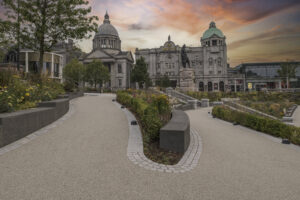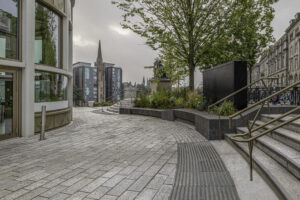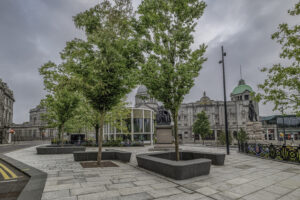Refurbishment

Historical significance
The refurbishment of Union Terrace Gardens in Aberdeen, Scotland, represents a significant restoration and enhancement of a historical public park.
The project began with a proposed masterplan by LDA Design (Glasgow) in 2016. The primary goal was to refurbish the Union Terrace Gardens while protecting its historical elements. The restoration project involved close collaboration with Historic Environment Scotland to ensure the protection and preservation of historical elements, including statues of Robert Burns and Edward VII.
The project included the refurbishment of Victorian toilets and the Arcade Arches, preserving their historical character. This restoration work aimed to maintain the park’s heritage. One of the notable improvements was enhanced ramped access to make the gardens more inclusive and accessible to all visitors.
New amenities

New amenities were added, including a play area for children, toilets, and cafés. These additions aimed to enhance the visitor experience. The project featured improved lighting throughout the gardens, making them safer for nighttime use.
The restoration work aimed to restore civic pride by reinstating the grand staircase and introducing new features like an informal amphitheatre and viewing platforms. The addition of a pavilion within Rosemount Plaza aimed to foster a sense of community and provide a gathering space.
The design proposals received a high public approval rating (91%), and Aberdeen City Council unanimously approved the planning application.
Stone selection

There were many factors considered with regard to the selection of materials for Union Terrace Gardens, including current and future stone availability, sustainability & durability, budgetary constraints and of course aesthetic qualities of the stone.
Given the Gardens location and prominence within the ‘Granite City’, a key consideration was the selection of stone which sympathetically complimented the local granites historically used within Aberdeen.
LDA Design worked closely with Hardscape to develop a longlist of potential granites for use within the Gardens. Through an extensive dialogue with Aberdeen City Council planning and heritage departments, and Historic Environment Scotland, this list was whittled down to the ultimately selected mix of European granites.
The sensitivities around the selection of stone materials, resulted in an extensive sample panel being constructed offsite to allow for the final finishes of the stone to be agreed. The variation in stone finishes has brought a subtle distinction in the tones and textures of the granites further adding to the qualities of the ultimate scheme design.
The selection of granite has resulted in the creation of a simple, elegant and robust ground plane which creates a background allowing key heritage and contemporary features shine brightly within the Gardens.
Hardscape’s skill and expertise have proven to be invaluable within this project, resulting in the selection of stone which successfully marries the past with the future, whilst complimenting the city as a whole. Hardscape worked collaboratively with the design team and contractor during the challenges of the pandemic as to ensure that the project was successfully delivered.
Hardscape were proud to supply a mixture of European granite paving, setts, steps and walling with combinations of Portuguese Silva Vilar, Cinza Ariz and Cinza Braga materials.
Transformation

The rejuvenation of Union Terrace Gardens has resulted in it regaining its place as the civic heart within the city. The Gardens are now an inclusive and dynamic space that will serve generations to come. Their restoration delivers on a city centre masterplan which is designed to invigorate the immediate area, providing a safe a sociable all-year-round destination with broad appeal, encouraging more walking and cycling.
Overall, the project aimed to combine historical preservation with contemporary enhancements, creating a vibrant and inviting public space for the community to enjoy. The choice of stone materials played a significant role in maintaining the park’s historical character while ensuring its durability and aesthetic appeal for the future.
